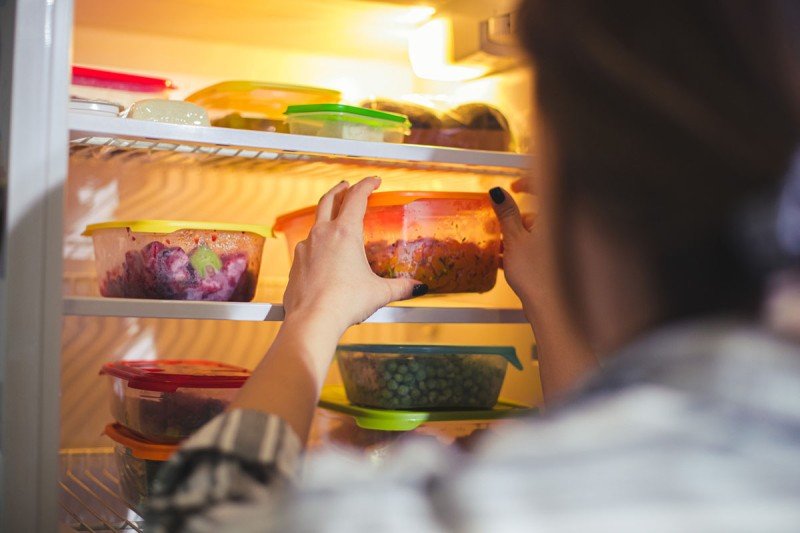
Storing food properly is just as important as cooking it properly in preventing foodborne illness.
Foodborne illness (also known as food poisoning) is a special concern for people with cancer. Their immune systems are weaker than those of the general public, which makes it harder to fight off dangerous pathogens in foods that are undercooked, past their expiration date, or improperly stored.
Historically, Memorial Sloan Kettering Cancer Center (MSK) and other cancer centers recommended that people with cancer follow a neutropenic diet, which eliminates raw produce, soft cheeses, fast food, and other foods that may overwhelm a person’s infection-fighting cells. To increase the variety of foods available to patients and also minimize risk of foodborne illness, clinical dietitians have focused nutrition education on food safety practices.
“We saw that patients were feeling restricted in what they can eat on the neutropenic diet,” says Peter Adintori, a clinical research dietitian at MSK. “The research we reviewed showed us that there was no increased risk when people followed a regular diet.”
Here, Peter and Hannah Husby, pediatric clinical dietitian at MSK Kids, walk through the fundamentals of food safety for people with cancer.
The four main rules of food safety are “clean, separate, cook, and chill.” Why are each of those important?
Peter: We wanted to make it easy for patients to remember the basics:
- Keep foods and the surfaces you prepare them on clean so you don’t introduce any outside bacteria.
- Separate foods that can potentially impact one another, such as raw meat and raw vegetables. You could be eating both of those in the same meal and you don’t want to cross-contaminate.
- Make sure food is cooked all the way through, especially higher-risk foods like meats.
- If a food is meant to be eaten hot, keep it hot. If it’s meant to be cold, keep it cold. Bacteria is more likely to grow on foods that spend too much time in the wrong temperature zone.
What has been the response from patients about relaxing some of the diet guidelines?
Peter: People are very happy to have more freedom. For example, we used to tell patients to avoid eating strawberries in the summer, when they are super sweet and tasty. But patients’ tastes can change quickly, especially when they are on chemotherapy, and berries might be the only food they like. We didn’t want to take that away from them.
Hannah: Since the diet is less restrictive, it also can help avoid fear and hesitation with food choices, which is a challenge while dealing with the side effects of cancer treatment, especially for our pediatric patients.
What are some common food-safety mistakes?
Hannah: You can cook something very thoroughly and make sure that it’s perfectly prepared but then not store or handle it properly. Or you can take something that is not inherently a risky food but keep the leftovers for too long. For example, rice itself is not unsafe, but when you keep it for too long, it can grow bacteria.
What are your thoughts on takeout food?
Hannah: It’s all about relative risk. Getting food to go is riskier than making food at home. A lot of our patients are here for an extended time. Toward the end of their stay, when I’m giving them guidelines to follow at home, I say, “You’ve been with us for so long; do you really want to come back just because you wanted takeout one night?”
Peter: Questions about takeout are some of the more challenging ones we get because, as Hannah said, there’s always some risk. With takeout, very few things are under our control. We don’t know how well the restaurant follows the “clean, separate, cook, and chill” principles. We don’t know how long the food has been sitting out. I always discourage patients from getting food delivered because you don’t know how long it’s been in the delivery car.
We used to say, “Don’t eat any takeout food for at least three months.” I think that was very hard for patients. What started happening was patients would still do it and just not tell us. We want to empower patients to make thoughtful decisions and keep the lines of communication open. I will say, one great takeout option is a pizza. My family owns a pizzeria, so I know that pizza is cooked past 550 degrees. Very few things are cooked at that temperature! I tell patients to ask for theirs unsliced — you don’t want to introduce bacteria with the pizza cutter.
How do you tailor your recommendations?
Hannah: A lot of this is about being able to navigate the evidence while doing our best to make sure patients feel seen and heard. It fosters a good relationship, one where they’re able to tell you: “Hey, I went to McDonald’s the other day. Is that OK?” I’m not going to scold you for that. It’s really a discussion. Food is so much a part of how people come together. The opportunity to share in the communal aspect of eating again is really a lovely gift that we can give them.
Peter: Hannah and I recognize the power of food in healing in a time when so few things are in the patient’s control. Food is a powerful tool we have to build relationships with patients, and we are so grateful to learn from them and partner with them during their time at MSK.



